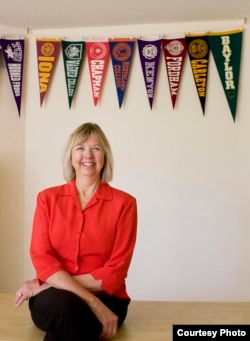"We wish you much success in your academic pursuits."
It's college acceptance, or rejection, time.
For many, a rejection letter from a college they had hoped to attend is the first big disappointment of their young lives. Many colleges add the "we wish you much success" line at the end of the already crushing rejection.
"No one wants to see a skinny envelope that says, essentially, 'no,'" writes calmom on College Confidential, a website for college applicants, students, families and others. Or an email that says no and then wishes you all the best. Ouch.
Sue Luse, a college admission adviser, suggests that students apply to a mix of schools. In college application-time code, schools fall into three categories: match, reach and safety.
Match schools are also known as right-fit schools, where an applicant's academics and/or extracurriculars -- like sports, music, art or other super power outside the classroom -- fit into the school's programs and academics. Oberlin Conservatory of Music in Ohio offers a strong music program, evidenced by 233 grand pianos on campus.
Embry-Riddle Aeronautical University in Florida and Arizona is pretty clear about its focus: Degrees in aviation, as well as engineering, space, computers, applied science and business.
Safeties are schools where an applicant's test scores and gradepoint average (GPA) are safely above the school's standards. Most large, state, public universities and community colleges are safety schools. The former makes it its mission to accept students from that state. The latter caters to students who live nearby and can commute to classes that are held on nights and weekends, too.
95 of 100 applicants rejected at this California school
Reach schools typically have low acceptance rates (also high rejection rates), and admit students that score the highest and have impressive skills outside the classroom. They can pick and choose among applicants. For some students coming from a community college, a private, liberal-arts university might be a reach if the student cannot afford the tuition.
Ivy League schools -- a group of older universities in the northeast -- fall into the reach category for most of their applicants. The acceptance rates are very low at top schools.
Stanford University in California reported that it turned down 95 of every 100 people who applied for admission to its current freshman class. The chances of getting in were not much better at other top schools such as Harvard University in Massachusetts and Yale University in Connecticut.
Columbia University, which recently sent out the mistaken acceptance notices, only admitted 6 percent of the 36,292 applicants for its 2016 freshman class.
Some schools are so selective, Luse said, that even the top students in their high school class are not guaranteed admission. Those are the reach schools.
In America, students are typically not discouraged by parents or school counselors to apply to reach schools on the chance they will get in. Schools also derive revenue from the application fees from each hopeful.
Applications "should include colleges [that students] know are difficult to get into, but others that are more likely to accept them,” Luse said.
“It could be that the school needs a quarterback for the football team, or they might need a tuba player,” she consoled.
If a student is rejected by a match or reach, a safety will guarantee that heartbreak is not final. Most students who go to a safety get over the disappointment when they make new friends on campus.
"Colleges are businesses and they are influenced by those factors which will allow them to rise in the rankings. In any given year they may be looking for more male students or more female students, or more kids from the Midwest or the South," wrote Helene Wingens, attorney and mother, on her blog. "Or as one college admissions officer told us, you’ll get admitted if you play the oboe in a year in which they’re looking for an oboist."
Students can transfer schools after their freshman year. The process starts very early, even before a student sets foot on their first campus. After attending a safety for a year and showing excellent grades and skills, students can try for a reach school by applying as a transfer student.
It is harder to get in than when parents went to college
It is important for parents not to take rejection too hard -- even when children are rejected from schools that they attended, Luse said. Parents should know it is more difficult to get into top colleges.
“It might be that when they went to that school, it accepted 30 percent of applicants and now that percentage is down to five percent,” she said.
The College Board prepares college entrance exams. It offers this message to students and parents getting bad news from their first college choice. Officials at top colleges say two-thirds of the students they reject have the ability to succeed at their schools.
Helping applicants understand they are among many smart people denied admission to top schools can help them better deal with rejection, the College Board said.
Anna Ivey, a college admission adviser and a former admissions officer, said students need a little time to get over being rejected by their top college choice.
“But then they need to get back to work and implement their Plan B,” Ivey said. By Plan B, she means considering other schools, or applying to new schools still accepting applications.
But there are schools that take in most applicants and some that accept all students who apply.
US News and World Report said that schools that accepted all applicants in 2015 included: The Academy of Art University in San Francisco, California; California State University in Bakersfield, the College of Staten Island in New York City and Herzing University in Wisconsin.
"None of this is personal. Colleges don’t love you or hate you. In fact, they have no feelings about you whatsoever," wrote Wingens. "The college admissions process is a game of chance where the odds of 'winning' at a few schools is close to nil and where once you’ve checked the grades and standardized test score boxes, the rest is out of your hands."
For extra credit, answer this question in the Comments section of this story or on our Facebook, Twitter, Instagram and LinkedIn platforms: Who received this famous rejection letter?
"We feel that your conclusions about the nature of light and the fundamental connection between space and time are somewhat radical. Overall, we find your assumptions to be more artistic than actual Physics." Think you know the answer? Leave it below, thanks!

